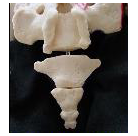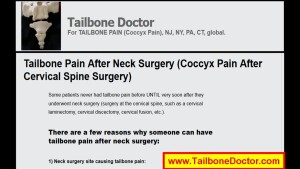Some patients never had tailbone pain before UNTIL very soon after they underwent neck surgery (surgery at the cervical spine, such as a cervical laminectomy, cervical discectomy, cervical fusion, etc.).
There are a few reasons why someone can have tailbone pain after neck surgery:
1) Neck surgery site causing tailbone pain:
- At the time of the surgery at the cervical spine, either the surgery itself or subsequent scar tissue after the surgery can cause some pulling, or traction, upon the “Dura”.
- The dura is the tissue or lining that surrounds the cerebrospinal fluid within the spinal canal.
- Since the lowest end of the dura is attached near the upper part of the coccyx, it is theoretically possible for traction or pulling up at the neck to cause tension down at the coccyx.
- This can potentially be a cause of pain.
2) Increased sitting/reclining after surgery causing tailbone pain:
- It is possible that there was an underlying coccyx condition all along, but it was not causing any symptoms.
- Examples of such underlying tailbone problems include: coccyx arthritis, or coccyx bone spur, etc.
- They may have never been symptomatic until the patient spent a significant amount of time laying or reclining.
- Especially problematic our hospital beds, where patients often have their legs out straight but the head of the bed elevated so the patient is in a somewhat reclining position.
- This position of sitting in a hospital bed or recliner puts a significant amount of pressure on to the sacrum and coccyx.
- In fact, this is largely why that specific area is a common site for bedsores in hospitalized patients.
- For someone with an underlying tailbone problem that never caused symptoms before, the time spent in this semi-reclined position may cause the tailbone problem to actually become painfully symptomatic.
3) Coincidence:
- Sometimes, the tailbone pain may be completely unrelated to the neck surgery.
- It is understandably tempting to assume that a new medical symptom that started must be related to the most recent major medical thing that happened in your life.
- But sometimes two things that happen one right after the other may be completely unrelated.
Evaluation and Treatment:
- Regardless of whether the tailbone pain is related to the cervical spine condition or not, it is important to have a thoughtful evaluation looking for anatomic causes of tailbone pain.
- Usually, a thoughtful and thorough evaluation will reveal an underlying coccyx problem.
- Common examples include coccyx arthritis, bone spurs, and probably most common is unstable joints at the tailbone.
- (To evaluate for unstable joints at the tailbone, patients need to have a special type of coccyx x-rays done specifically while the patient is sitting. The coccyx x-rays are done while sitting since that is the position that is usually most painful and that is the position where the patient’s body weight is on the tailbone and may be causing abnormal movement of the coccygeal bones.)
To get a copy of the book, Tailbone Pain Relief Now! go to Amazon, or: www.TailboneBook.com
For more information, or to come for an evaluation by Dr. Foye at the Coccyx Pain Center, go to www.TailboneDoctor.com
Latest posts by Patrick Foye, M.D. (see all)
- Coccygectomy: Expected Recovery and Return to Work after surgery for coccyx pain, tailbone pain. - November 28, 2023
- PRP Platelet Rich Plasma or Prolotherapy for Tailbone Pain, Coccyx Pain - October 25, 2023
- Reasons for Normal X-rays and MRI Despite Tailbone Pain, Coccyx Pain - October 3, 2023


